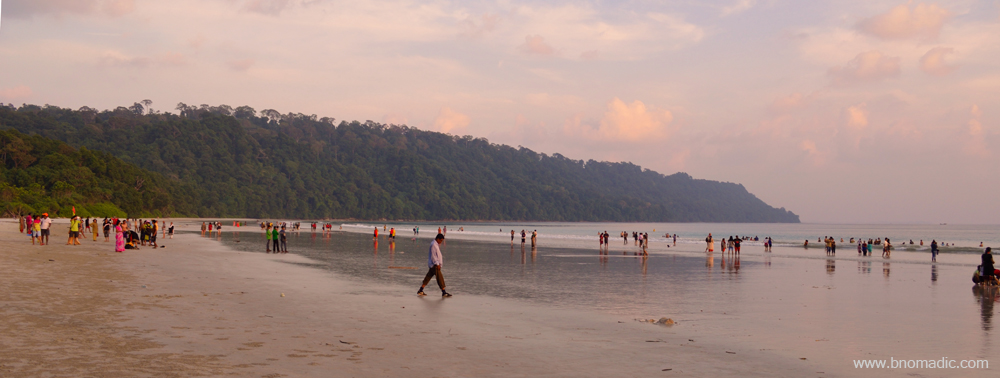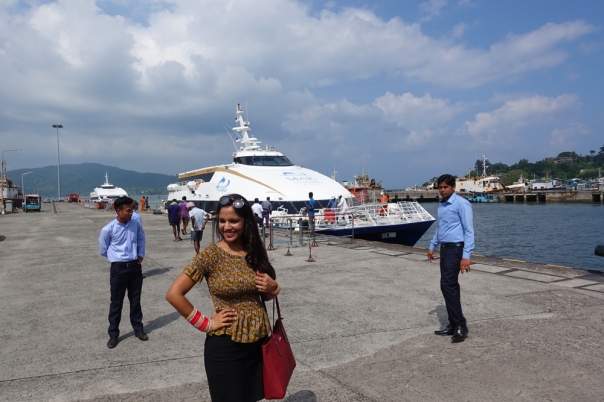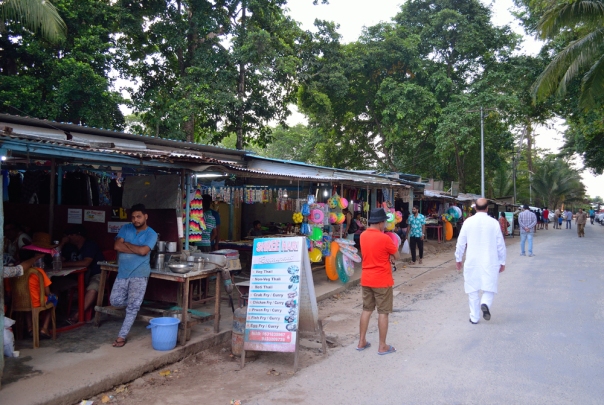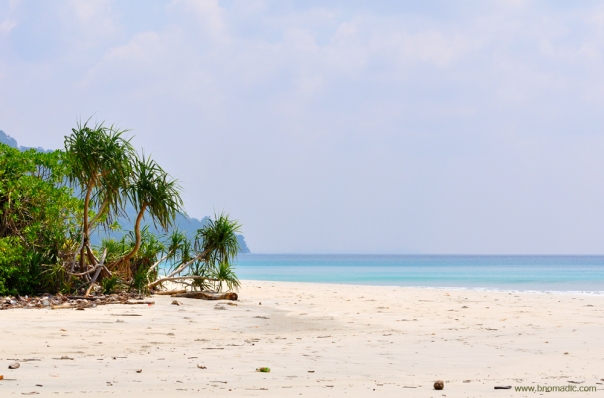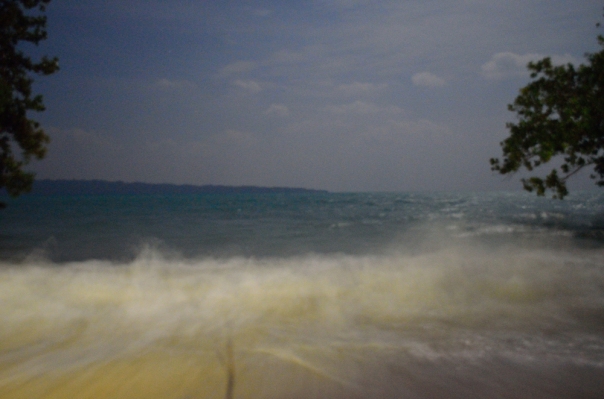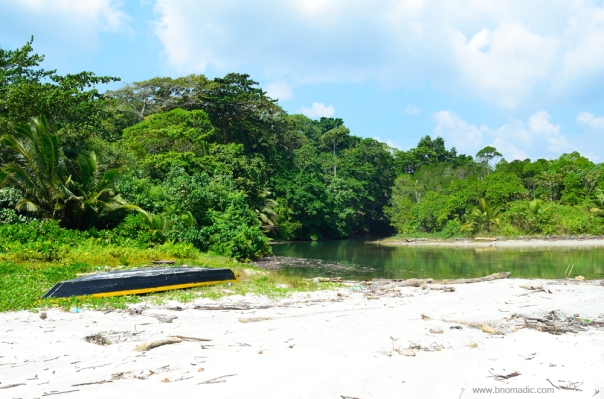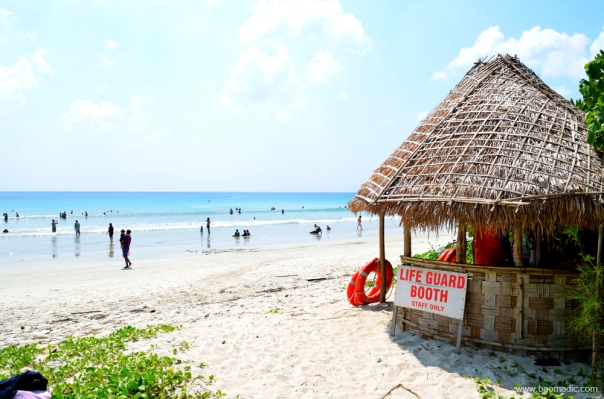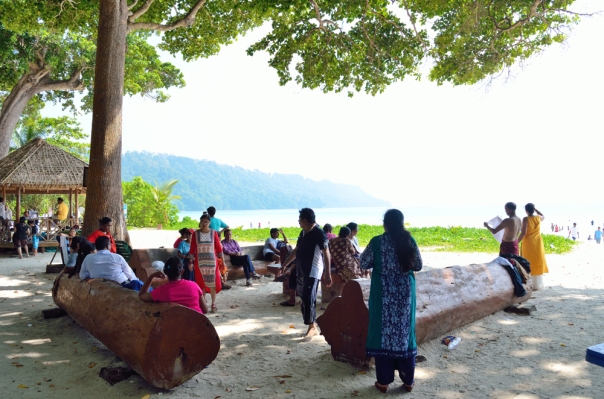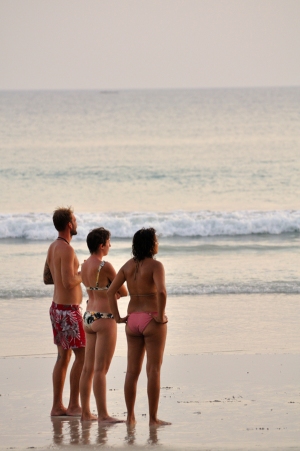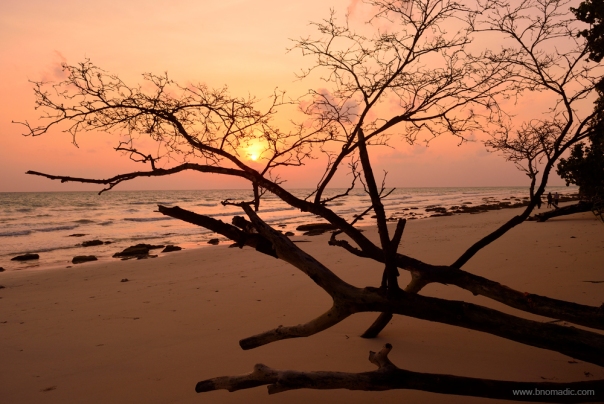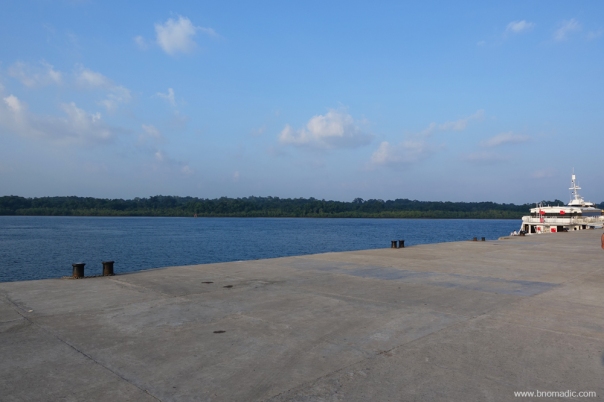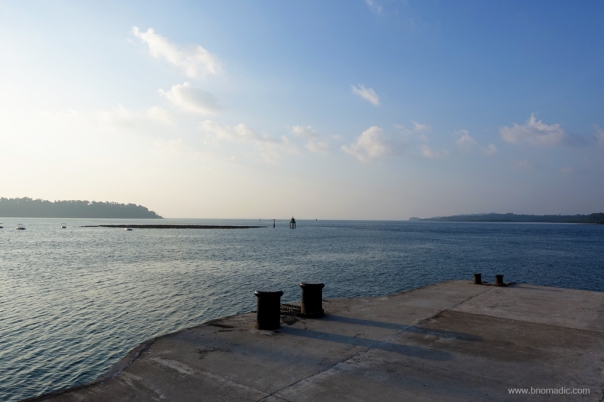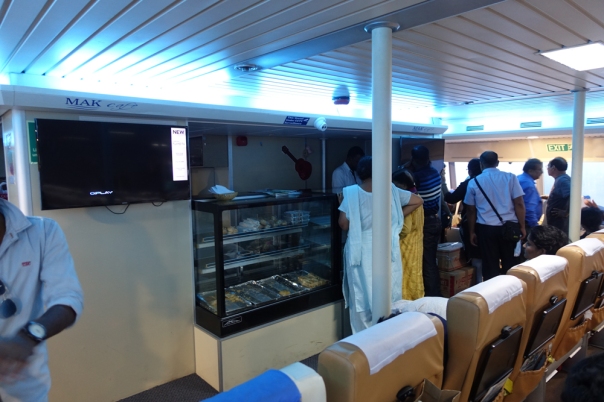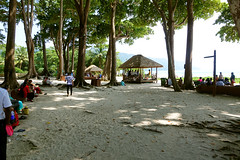When I began planning this trip about a month ago, I was intrigued at the thought of how distant and isolated the island group of Andaman and Nicobar actually was. The Andamans are even farther than what I used to mark on a physical map of India during my school exams. The nearest Indian mainland port is around 1300 km from Port Blair, the capital township of the islands. Beautiful beaches, magnificent sea creatures, lush forests, strange tribes, a penal housing, kalapani and the devastating tsunami of 2004 basically sums up what I knew of these islands till recently. An involved research brought some more interesting facts about these islands.

Finally at the Veer Savarkar International Airport of Port Blair. More images at Flickr
Aboard a Jet Airways flight, I spread a map-cum-fact sheet of the Andamans as I patiently wait for the aircraft to take-off in Chennai. The airport operations are temporarily put on hold to facilitate a VVIP movement. Of the total of 572 islands in the Union Territory of Andaman and Nicobar Islands, only about 38 are permanently inhabited, the unverified document says. Separated by a 150km wide turbulent Ten Degree Channel, the Andaman group has 325 islands, whereas, the Nicobar group has 247 islands. The closest foreign land mass is Coco, a Burmese group of islands that lie approximately 20 km away from the northernmost tip of the Andamans. The next couple of hours or so on the flight to Port Blair, the gateway to the islands, are spent in planning and identifying day walks for the next one week.

Port Blair is situated on the southern end of the main landmass of the Great Andaman Island. As the aircraft begins to descend and land on the Veer Savarkar International Airport of Port Blair, I am awestruck to see the seascapes from above. I hadn’t seen anything like that before. Outlined by sugar-white beaches, the lush forests or mangroves of the islands are surrounded by shimmering turquoise waters of the Bay of Bengal. The sky is clear. Our plane must have been flying over the islands of the Mahatma Gandhi Marine National Park, I assume. The spectacular view of the deep blue sea instantly vanished as a submerged patch appeared. The next moment our aircraft is taxing on the Port Blair airstrip, the foundation of which was laid by the Japanese during the World War-II, and is now jointly managed and used by the Airports Authority of India as well as the Indian Navy.
Finding an accommodation could be a tricky exercise in a tourist season on these islands. Accommodation is plentiful but so is the tourist rush. Apart from construction material and furnishings, most properties have to source raw materials for food and provisions, etcetera from the mainland, hence, the rents and charges are mostly inflated, especially in the on-season. Not that the low budget options aren’t available in the town but it is advisable to book a few months in advance. Given the flight and inter-island ferry timings, most properties have an 8 AM checkout policy. The early checkout timings might cause a little annoyance but the good thing is that the sunrise timings in these islands precede the sunup in the Indian mainland by an hour and a half approximately. Another concern while identifying an accommodation could be transportation. Even though, cabs, autos and buses are readily available but fixing one might involve a little bargain. Thankfully, my accommodation is pre-booked and so is the transportation.

Room with a view; the island in front is what is printed on a Rs 20 currency note. More at Flickr

A boat ferrying between the Ross Island and Port Blair; a tourist boat had capsized in these waters in 2014
Overlooking the blue sea, my accommodation is positioned atop a hillock. The chief promenade of the town, the marine drive that seems to encroach upon the territory of the sea is in full view along with the Aberdeen jetty. Far towards the left, I could spot the remaining three distinct spokes of the Cellular Jail. Right in front in the middle of the sea is a tiny island known as Ross that is gazing out to sea like a sentinel. I gaze at the exquisiteness of the seascape – the forested islands and the shining hues of the Andaman seas, which, for many centuries, have remained a mysterious as well as dreadful region to the rest of the world. Even till few decades before, the sailors passing through the Bay of Bengal held the belief that natives of these beautiful islands were cannibals. And because of this infamy, Andamans continued to be feared. Merchant ships from across the globe passed through the international trade routes which lay close to the islands. Many a time, due to natural calamities or urgencies, some of such ships made desperate attempts to anchor at the islands. On most such unfortunate occasions, the sailors received sudden but savage response from the aborigines. Not many would come back alive. As far as possible, ships tried to avoid passing close through the islands. If a visitor somehow managed to remain hidden from the sight and sharp arrows of the aborigines; the calamitous weather, shortage of food and the life-threatening malaria would make the survival a chanced affair.

The Raj Niwas, the residence of Lieutenant Governor, Port Blair. More images at Flickr

Sea view from the garden of the Raj Niwas. Please visit Flickr for more images of the region
When the British began to establish a penal settlement at an island, Chatham inside the Port Blair harbour, the aborigines fiercely resisted all acts to do so. After the initial survey of the islands in 1777 by John Ritchie, the East Indian Company appointed Captain Archibald Blair, a hydrographer and Colonel Colebrook, the Surveyor General to survey the entire archipelago and its surroundings in 1789. In their findings, they wrote that the islanders are probably among the most primitive human beings in the whole world. With much difficulty and superhuman efforts, Captain Blair managed to drive away the natives, clear some forests and build some houses and penal structures in the same year with the help of a few Bengali labourers and skilled workers which he brought from the mainland for the purpose. Gradually, the East Indian Company began to gain a foothold in these islands; nonetheless, a location of strategic importance in the busy Bay of Bengal. Before commencing the construction of the infamous Cellular Jail in 1879, the British had to twice shift the penal colonies from South Andaman to North and then back. Underestimation of the catastrophic climate, savagery of the aborigines and malaria kept them occupied. Subsequently smaller penal structures were added in the vicinity of Port Blair, such as in the Viper Island.
For the next four days, I keep myself engaged in understanding and exploring the streets and corners of the island town of Port Blair. On all days, almost unavoidable to visit was the centrally located Aberdeen market, the main and the town’s most crowded portion. Port Blair was a new land; and the British tapped the opportunity and named the landmarks or islands as per their whims and fancies. This area, Aberdeen was the site of the largest armed conflict – between the British and the Andaman aborigines in 1859 – which later came to be known as the Battle of Aberdeen and marked the beginning of Struggle for Freedom by the natives. The homesick British subsequently named this area after Aberdeen of Scotland. Adjacent to the Aberdeen Market, there is a settlement by the same name. The settlement of the town later developed around it.

A closeup of the Snake Island as observed from Port Blair. More images from the region at Flickr

The Aberdeen Market; the Police Gurudwara is also in the frame. More images at Flickr

The Annapurna Cafe is among the popular food joints especially for South Indian cuisine. More at Flickr

My South Indian Thali at the Annapurna; the butter milk. More images from the region at Flickr

The Fisheries Museum, Port Blair exhibits specimens from underwater life. More at Flickr

Relished both the varieties of Coconuts, grown here through plantation farming. More at Flickr

The Anthropological Museum exhibits portraits and artifacts of the aborigines. More at Flickr

Inside the Anthropological Museum. Please visit Flickr for more images of the region

Hunting tools used by the aborigines. More images from the region at Flickr

Some more tools. Please visit Flickr for more images of the region

The souvenir shop at the Anthropological Museum. Please visit Flickr for more images
Superficially, the town may not look any different from most small towns of the Indian mainland. But of course, the landscape is an exquisite combination of hills and seas; with all shades of greens and blues. Soon I realised that here everything is based on marine economy; and water, its perils and pleasures surrounds just about everything. Villages and tehsils are separated not by roads but sea; boats or ships are the popular mode of transport; vehicles assemble at jetties where reservation counters booked a ship ticket; seafood is the popular street food; museums showcased marine shells and trophies; bays, coves and beaches presented promenades; travel plans are dictated by the timing of high tide or low tide; shape of the moon is a factor in dictating transport safety; checking precise tidal information from newspapers is an essential part of daily chores.

The Lalaji Bay View Guest House is a budget alternative for backpackers. More images at Flickr

The Excel Restaurant atop the Lalaji Bay View Guest House. More images from the region at Flickr

The Fruit market, Port Blair; most of the fruits are sourced from the Indian mainland. More at Flickr

The Samudrika Naval Marine Museum that showcases marine life including some shells. More at Flickr

Artillery Gun used by the Indian Navy at display. Please visit Flickr for more images of the region

A flat screen that shows travel documentaries about Andamans; people watch it mostly to take a rest

The Sagarika store at Port Blair. Please visit Flickr for more images of the region

Inside Sagarika

Inside Sagarika
Most of the popular places of interest in the town like Fisheries Museum, Cellular Jail, Corbyn’s Cove, Mini Zoo, Japanese Bunkers, Anthropological Museum, Chatham Saw Mill, Samudrika Naval Museum, and etcetera are located within an easy access from the Aberdeen Market. I visit all these landmarks one by one. There are many attractive picnic spots in the vicinity of the town. A popular one is Corbyn’s Cove, a safer beach for bathing and seaside activities, where the sea has neither underwater rocks nor predatory fishes. A government-raised coconut plantation fringes the beach. Every year monsoons make this cove tempestuous when waves unceasingly crash on to the land and every year a little bit of Corbyn’s Cove along with a swathe of coconut palms is swallowed up by the ocean. The administration has built a concrete sea wall to check this erosion. The beach is named after Reverend Corbyn by the British. A padre of Port Blair, Corbyn was employed by the British to befriend the natives and win their trust after the natives did not stop attacking the settlements. For the purpose, Corbyn had set up the Andaman Home, a cluster of huts at the Ross Island, where Corbyn tried offering them material blandishments.

The sea is relatively calm here except in the monsoons. Please visit Flickr for more images
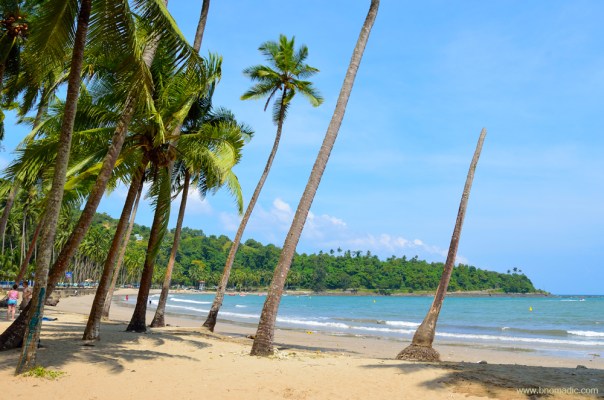
Corbyn’s Cove is located close to Port Blair. Please visit Flickr for more images of the region

A Japanese Army bunker at the Corbyn’s Cove, Port Blair. Please visit Flickr for more images

The beach is lined with many shacks. Please visit Flickr for more images
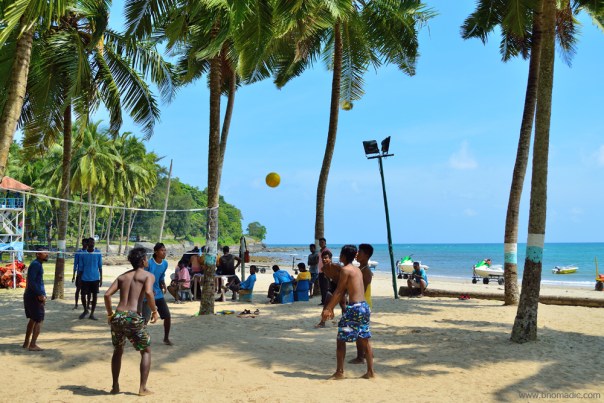
Tour operators and life guards playing beach volley. Please visit Flickr for more images

The beach is considered safe for bathing and swimming. Please visit Flickr for more images

Coconut plantation by the Corbyn’s Cove beach

A mobile cam image of a typical sunset from Chidiya Tapu; the stinger net enclosure provides protection against crocodiles and predatory marine life
I devote two evenings to visit the most popular landmarks of the Andamans – the Cellular Jail and the Ross Island. The Light and Sound show makes the evenings here particularly noteworthy. Before entering the Cellular Jail premises, I stand in front of the main entrance on the road and pay my obeisance to the freedom fighters. The entry to the jail complex is through a gate placed in the middle of a large two-storeyed wooden building. Two rooms on either side, which served as the jail office when the jail was in use and later converted into hospital, now housed jail memorabilia. I wander around the imposing structures, from one wing to another, once again awestruck at the fortress-like construction that looked practically impregnable. Overwhelmed with a mixture of wonder and sorrow, I muse over the past of this complex. I am staring at the walls of the complex that had been home to so many tortured and tormented people. Even the very name of the Cellular Jail would instigate terror in the mind of the most hardened criminals. It is not hard to reconstruct the terrible activities that happened behind the prison walls of the Cellular Jail, the Bastille of India.

The Cellular Jail is among the most popular landmarks of the Andaman & Nicobar Islands. More at Flickr
Replicating the Pentonville Prison of Britain, the Cellular Jail was constructed in such a manner that a lone sentry could guard all the cells by remaining around the watch tower. Escape was nearly impossible. With the bricks and other material for construction brought on ships from Burma, convicts were made to work as slaves. At one corner of the complex are the old gallows that could support three nooses. The original sample oil press is still put on display inside the compound. A convict would push the rod, moving in circles around the bowl to squeeze out at least 15 seers of mustard oil a day. Near the oil press is a man-sized iron flogging frame to which stripped convicts were fastened and flogged till they started bleeding. I feel transported to our tragic past when the convicts were treated in an absolute brutal way. A thorough disregard to rules, regulations and fair play was observed. Frequent spread of disease, unhygienic food and torturous living arrangements were the norm. The inhumanity of the British was unimaginable. The convicts desperately looked for opportunities to escape from the hell-like settlement.

The accessible wing of the compound stands a mute witness to the tortures meted out to the convicts

Bearing a testimony to the tortures of the olden times, the workshop has old memorabilia.

A sample Oil Press. Please visit Flickr for more images of the region

The exhibition hall showcases old photographs of the convicts, their activities and the jail. More at Flickr

The gallows, built next to the mess, could support up to three nooses. More images at Flickr

The structure below to collect corpses

Today, the National Monument has also almost become a pilgrimage center. More images at Flickr

Curious visitors probing the unique door lock system; the glorified Savarkar cell in front

A sentry could observe all seven wings from the watchtower

View from the terrace of the wings. Please visit Flickr for more images of the region

The view of the sea and the Ross Island from the terrace of the Jail. More images at Flickr

View towards the North Bay from the terrace. Please visit Flickr for more images of the region
Of the seven wings of the original Cellular Jail, only three remained intact. Rest all were demolished at different point in time for clearing the area. The bricks were later reused including for making a hospital at the same site. Today only a solitary wing is open for visitors and stand as a mute reminder of the despicable acts of the British. I wander around the complex prudently observing the cells. The small cells were ventilated by a tiny skylight built closer to the ceiling. The uniquely designed huge locks are still intact. The entire arrangement was so cleverly designed that it was next to impossible for a convict to reach the lock from inside the cell to set him free. The last cell of the top floor was assigned to Veer Savarkar, the most politically celebrated convict of the jail who was assigned 50 years of solitary life confinement. He was arrested in 1910 but somehow managed to be released by 1921. To me, the convicts of the Gadar Party, who came to the jail in 1915, deserved a special accolade. These tall, muscular, heavily built prisoners, who were mostly Sikhs, started to instead create trouble for the authorities. The Gadar prisoners resorted to protest after protest, strike after strike, testing the very limit of the tolerance of the jail authorities. Sensing the trouble, the British sent them back to the Indian mainland by 1921 after which jail conditions improved drastically for the convicts but only for a short while.
Perhaps afraid of the threat posed by the aborigines as well as the revengeful convicts, most top officials, along with their families, of the British preferred to stay at the small Ross Island. I board a boat for the Ross from the Aberdeen Jetty. It takes less than 10 minutes in reaching the Ross Jetty. After the Indian Navy set up a base in the Andamans as an aftereffect of the Sino-Indian war of 1962, INS Jarawa was commissioned to oversee all naval operations on the islands. With no permanent habitation at the island, the Ross now comes under the purview of the INS Jarawa. The red-painted remnants of a flourishing past along with the natural beauty of this small island overwhelm me. A well-kept Japanese army bunker that was obviously a later addition as the British were preparing to leave the island is positioned at the jetty.

The Ross Island as observed from Port Blair. Please visit Flickr for more images of the region

The Aberdeen Jetty; the Ross Island in the backdrop. Please visit Flickr for more images
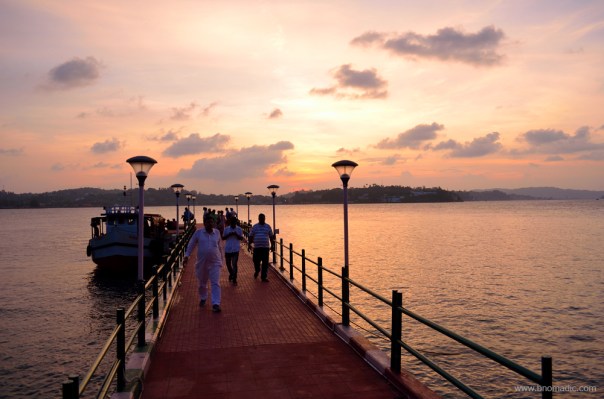
The Ross Jetty; Port Blair in the backdrop. Please visit Flickr for more images of the region

A bunker constructed by the Japanese Army during the World War II. More images at Flickr

The ruins of Ross Island; frankly I was not expecting anything like these memoirs of the past on the Ross; the deer were brought to the Andamans by the British in 1920s. More images from the region at Flickr

With most modern amenities of a civilised town, what Ross must have been when it was the garrison headquarters of the Andamans. Please visit Flickr for more images of the region

The island is now a part of the INS Jarawa, maintained by the Indian Navy. More at Flickr

Palms, dappled shadows and weathered ruins greets a visitor to the islands. More at Flickr

Ruins of the Anglican Church at the Ross

The expanse of sea between the Ross Island and Port Blair. Please visit Flickr for more images of the region
The British are the masters in making life comfortable for them. The ruins of luxuriant houses, clubs, a swimming pool, shopping arcade, bakeries, tennis court, ball room, paved streets, testifies the quantum of how smooth and luxurious life must have been for the British at the Ross during those times. Boats were the only means of transport then, even as hundreds of convicts were used the British to clean and maintain the surroundings. A major earthquake in past caused several structures at the Ross to perish after which a few geologists pronounced it to be a sinking island. The Ross was abandoned in 1941. Later the Japanese whenever needed to construct a new building they merely broke down some of the existing buildings at the Ross and used the bricks and beams. Today it has become a picnic spot for the visitors. True to its character as a natural outpost, on the opposite side of the Ross, the sea stretches uninterrupted for miles and miles around. Militarily speaking, the Ross is an ideal place to watch the movements in the Bay of Bengal and see the approaching ships.

The Light and Sound show at the Cellular Jail. Please visit Flickr for more images of the region

The Light and Sound show at the Ross Island. Both shows give all the necessary information to further intrigue your mind. Please visit Flickr for more images of the region

Tsunami Memorial to commemorate the lives lost in the Andamans in 2004 tsunami. More at Flickr

A memorial constructed in honour of the tribesmen who died in the Battle of Aberdeen
One thing is pretty much evident from the recent history of Port Blair that the birth of the civilisation in these islands has had a much bittered journey. The light and sound program at both locations basically sums it all. Overall, I wouldn’t have ever imagined that in such far waters, such a beautiful and intriguing region existed.
Getting There
Plainly speaking the island capital town of Port Blair may not be any different from other small towns of Indian mainland except for the blue and clean seaside. The laid back capital of the Union Territory of Andaman and Nicobar Islands is nearly 1300 km from Indian mainland. The route is connected with the mainland through sea as well as air. Depending upon the sea weather, a ship may take anywhere between two to four or even five days in reaching Port Blair from the East Coastline of India. Most domestic airlines operate flights to Port Blair from the main Indian cities. A flight from Chennai usually takes a little above couple of hours in reaching Port Blair. In terms of expenses and time, flight option proves to be more economical than a ship. Foreigners will require a Restricted Area Permit – which can be issued at the origin port if travelling by ship or upon arrival at the Port Blair International Airport, if flying in – to visit the islands.
Best time to visit: Any time of the year except monsoons
Travel Lure: Beaches, Heritage, Wildlife and Marine life
Accommodation: Plentiful but always confirm in advance



 bNomadic
bNomadic




